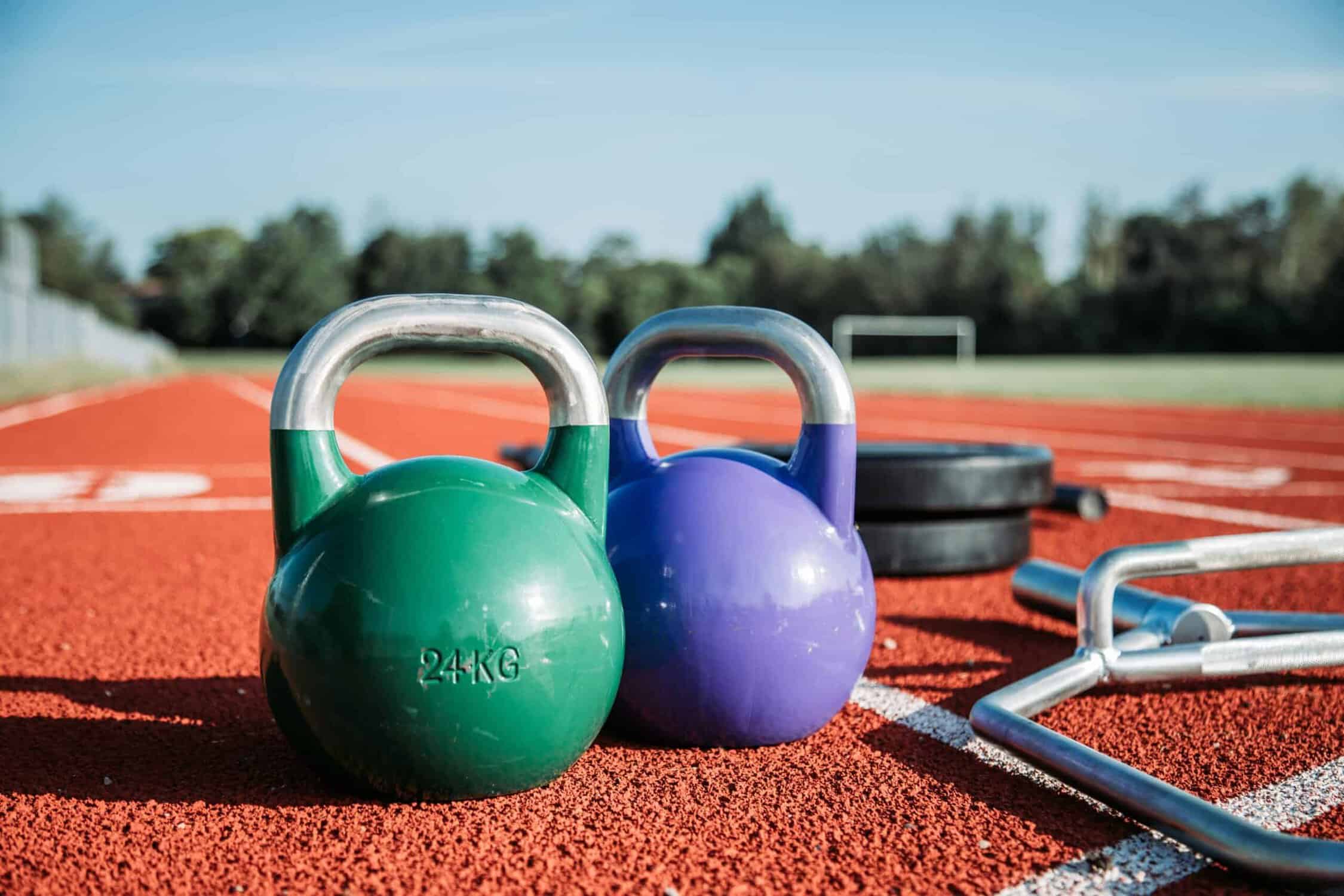Strength training gets a bad rap among runners. But countless studies show incorporating full body strength moves into your weekly training plan for endurance runners is a secret weapon in preventing running injury, building muscular endurance, and improving running economy. One of the easiest way to improve your strength as a runner and athlete: kettlebell workout for runners.
A kettlebell workout for runners is highly effective . They’re a versatile piece of equipment – and a favorite of running coaches and personal trainers, like Erica Coviello, a RRCA-certified running coach and ACE-certified personal trainer.
Coviello says kettlebells can be used for tons of different moves, targeting multiple muscle groups at once, and force you to engage your core while performing lifts.
Here, we’ll look at the benefits of kettlebells, how to choose the right weight for you, and go through a quick but effective kettlebell workout for runners.
Why Strength Training Is Great for Runners
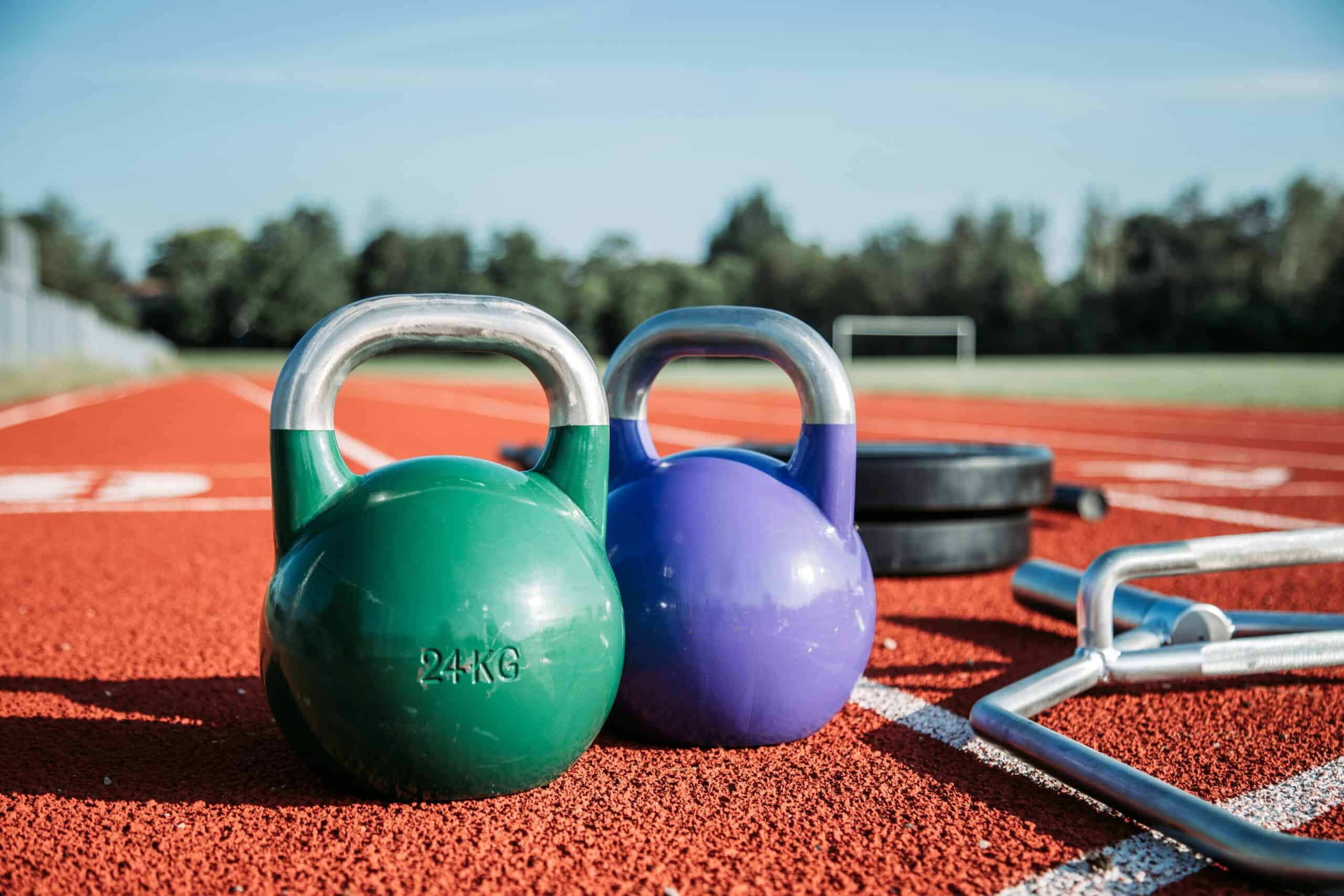
“Strength training workouts can do wonders in helping runners avoid injury,” says Coviello. Maybe you’re training for a 5K, maybe you’re going full out for a half marathon. Either way, “exercises that can help you build mobility and strength in your glutes, hamstrings, quads, and core will make you a stronger, less injury-prone runner,” Coviello adds.
A 2022 meta-analysis in Sports (Basel) showed that strength training can help improve how efficiently endurance runners use energy while running. Specifically, when athletes added strength training to their usual running routine, their running economy improved. This means they used less energy to run at the same pace.
What’s more, one study in the review showed that after 10 weeks of combined strength training with endurance training, runners improved their running economy by about 4%.
Why Runners Should Strengthen With Kettlebells
Kettlebell training can strengthen your quads, glutes, hamstrings, hips, core muscles and upper body – often simultaneously.
Here’s why kettlebells are a great piece of equipment to get the job done:
- They’re versatile: When you’re comparing kettlebells to other weights and equipment, you can use ‘bells for a wider variety of exercises, from classic deadlifts and squats to more dynamic movements like swings, get-ups, and snatches.
- They are always developing strength in multiple muscles groups and, especially, your core: A 2024 study from researchers in India explains that kettlebell training is “fundamentally functional,” meaning every exercise with the equipment integrates multiple muscle groups and builds core stability. Coviello echoes this idea, saying that nearly every kettlebell movement builds core strength for stability and control. Combined with the engagement of multiple muscle groups simultaneously, she adds that this can help with your body’s overall balance.
- They’re easy to store: Kettlebells are relatively small and compact, making them ideal for home workouts or spaces with limited room. Additionally, they are easy to transport, so you could bring them to the track if you’re looking for a spicy workout.
Kettlebells vs. Dumbbells
When most of us think of strength training, we think of dumbbells. Both equipment types have many of the same benefits and, ideally, you have both in your home gym. But there are some areas where kettlebells outpace dumbbells:
You get more bang for your buck with kettlebell’s versatility. There is a ton of research showing kettlebell’s benefits on building well-rounded fitness:
- That same 2024 review from Indian researchers reports combining high-intensity interval training with kettlebells can build better cardiovascular fitness.
- An older, landmark study from the American Council on Exercise (ACE) found that a 20-minute routine with kettlebells can burn as many calories as a 6-minute mile pace for the same amount of time.
- Other research shows classic HIIT workouts using kettlebells had positive changes on strength, endurance, cardio, and speed.
- A 2015 study in The Journal of Strength & Conditioning Research looked at how kettlebells improved the aerobic capacity of athletes and found that kettlebell moves – particularly snatches – increased the athlete’s maximal oxygen consumption (V̇O2max).
Dumbbells are suitable for metabolic conditioning as well, but certain exercises like kettlebell swings, snatches, and goblet squats are easier and safer to perform with a kettlebell.
Also, kettlebell exercises often involve more mobility than dumbbells. “Better mobility is an added bonus of kettlebell training,” says Coviello. She says the added flexibility helps prevent running injury.
Additionally, kettlebell exercises can more effectively mimic functional movements thanks to the shape and exercises that are similar to real-life activities, making you stronger in everyday life.
How to Choose the Right Kettlebell Weight
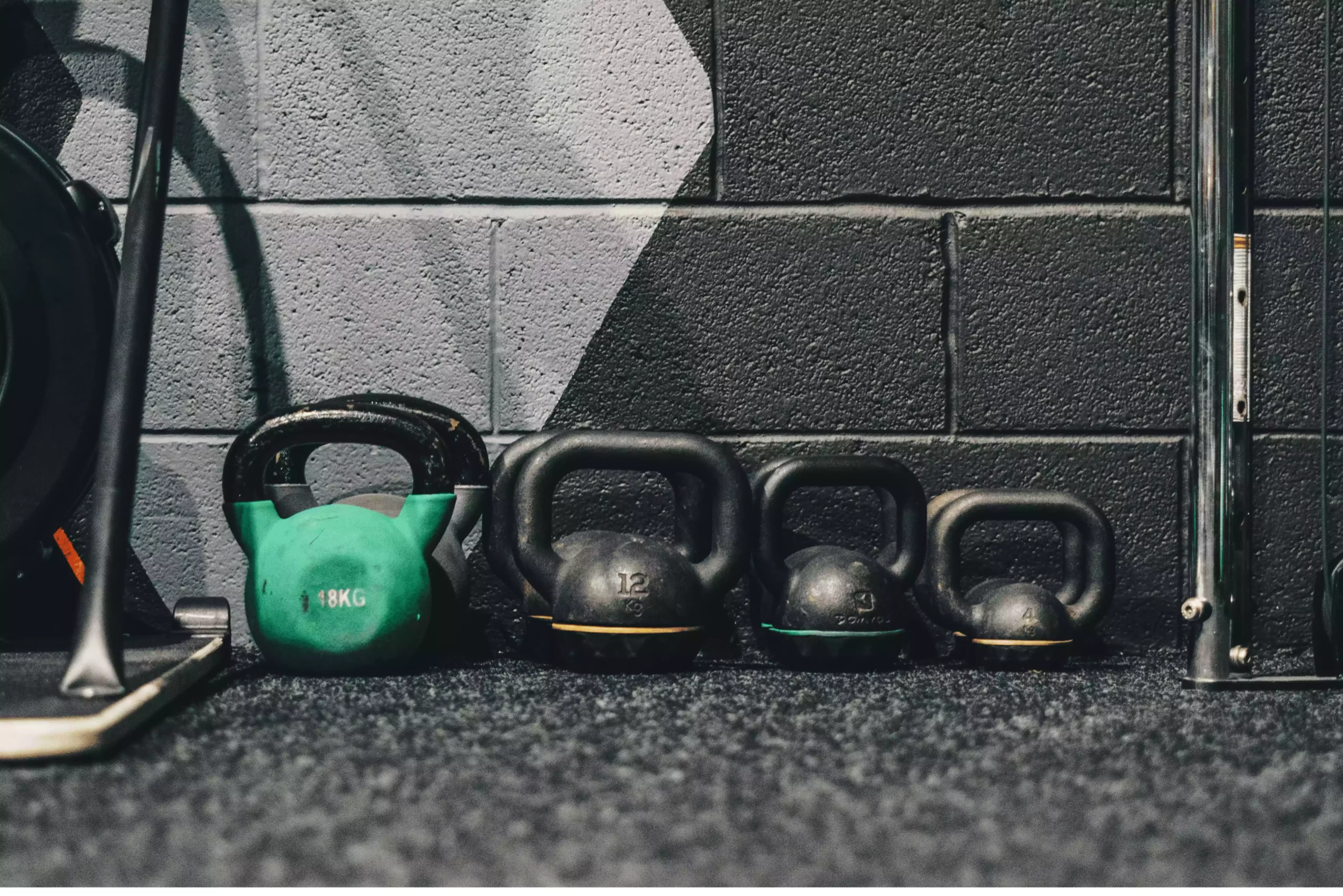
Kettlebells come in a variety of weights. The tiny, 2 to 5 lb kettlebells are excellent for rehabbing injuries. There are also behemoths that most endurance athletes won’t ever really need.
Coviello says the sweet spot for runners is generally a 15 or 25-lb bell for women and a 35 to 45-lb bell for men when it comes to a highly productive kettlebell workout for runners.
Choosing the best kettlebell weight will, of course, depend on your strength:
- If you are currently training for a race, opt for a lighter kettlebell (i.e. 15 to 35 lbs depending on your current fitness) so you don’t exhaust your muscles while running a lot of miles per week.
- In your off-season, incorporate more heavy lifts and plyometric movements to focus on your fast-twitch muscle fibers.
Your Whole-Body Kettlebell Workout for Runners
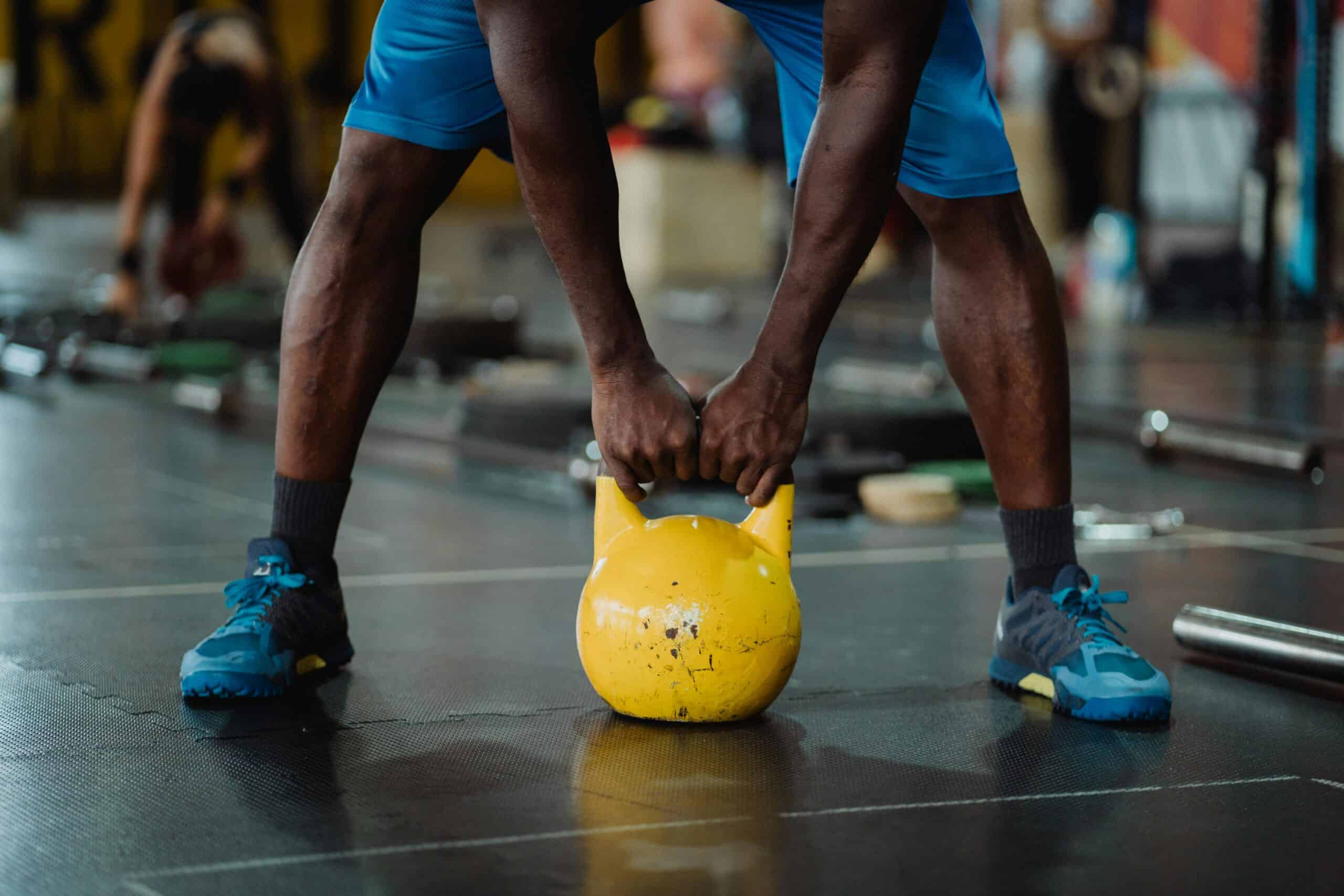
As a running coach and certified personal trainer, when Coviello designs a strength-training program for runners, she makes sure to keep the moves simple while ensuring each move contributes to improved performance.
Her program should be challenging but not exhausting.
“Try to schedule two to three strength training sessions per week, making sure to give your body enough time to recover,” she advises.
This routine, her kettlebell workout for runners, will give your muscles the right amount of challenge to improve without pushing them too hard to affect your running training.
1. Warm Up
Completing 30 seconds each of the following bodyweight movements:
- Jumping jacks
- Jog in place
- Butt kickers
- Neck rolls
- Shoulder circles
- Plank walkouts
2. Kettlebell Goblet Squats
Reps: 10
Sets: 3
How to do it: Grip the kettlebell close to your chest with both hands. Stand with feet shoulder-width apart. Lower your body into a squat position by bending your hips and knees.
Here, try to keep your chest upright. Your thighs should be parallel with the floor, but only lower as far down as you feel comfortable. It will improve over time. Keep your heels on the floor. You should feel this in your quads and glutes.
In one fluid motion, push out of your feet back up to standing.
3. Kettlebell Deadlifts
Reps: 10
Sets: 3
How to do it: Start standing with your feet shoulder-width apart. Hinge at your hips while keeping your back straight. Reach down to grab the kettlebell handle with both hands. Keep your arms straight.
To come back up, drive through your heels, straightening your hips and knees. Engage your glutes at the top. Lower back down until the kettlebell reaches the floor and repeat.
This exercise is important for posterior chain strength. Advanced athletes can try single-leg deadlifts, but if you’re just starting, opt for both feet on the floor.
4. Kettlebell Front Lunge
Reps: 10 each leg
Sets: 2
How to do it: Stand with your feet together. Hold a kettlebell with both hands tight to your chest. (Most people prefer holding the bell upside down during this move for a better grip.)
Step your right foot out directly in front of where it was and bend both knees so that your front leg is at a 90-degree angle. Your left foot should be up on its toes. In this position, make sure that your front knee is not collapsing inward and that your knee is directly above your ankle.
Step back. Repeat on the other side.
5. Kettlebell Back Lunge
Reps: 10 each leg
Sets: 2
How to do it: Stand with your feet together. Hold a kettlebell with both hands tight to your chest. (Most people prefer holding the bell upside down during this move for a better grip.)
Engage your core and step your right foot back, bending both knees so that your back leg is at a 90-degree angle. In this position, make sure that your back knee is not collapsing inward and that your knee is directly above your ankle.
Step back. Repeat on the other side.
6. Kettlebell Swings
Reps: 10
Sets: 2
How to do it: Eork up to this move slowly to ensure you get the technique right before going ham on sets and reps. The power should come from your hips, not your arms.
Start with your feet hip-width apart, toes pointed slightly out, and kettlebell grasped in both hands by the top of the bell. Bending at the hips, drive the kettlebell back between your legs. Brace your core and explosively extend your hips, knees, and ankles forward to swing the kettlebell out in front of you. Keep your arms straight, and let the power generated from your hips propel the kettlebell to chest height.
Allow the kettlebell to swing back to your starting position and repeat.
7. Kettlebell Half Get-ups
Reps: 4 each leg
Sets: 2
How to do it: This is a tricky one to follow, but it’s so good for core stability and body awareness. If you have any knee troubles, either place a blanket under your knees or skip this move.
Start in a kneeling position. Extend your right arm straight overhead while holding a lightweight kettlebell with a firm grip.
Bring the right leg up so that it is in front of you in a lunge position (the back knee should still be on the ground). Using your core and right leg, raise yourself up and have the left foot meet the right foot so you are in a standing position.
Repeat on the other side.
8. Weighted Bridge
Reps: 5
Sets: 3
How to do it: Lie on your back with your knees bent, feet on the ground, and kettlebell resting on your just above your hips. Engage your core and drive through your heels to lift your hips.
Hold and engage your glutes for a count of three. You should feel tension in your hamstrings and glutes.
Return down with control and repeat.
The Kettlebell Workout For Runners
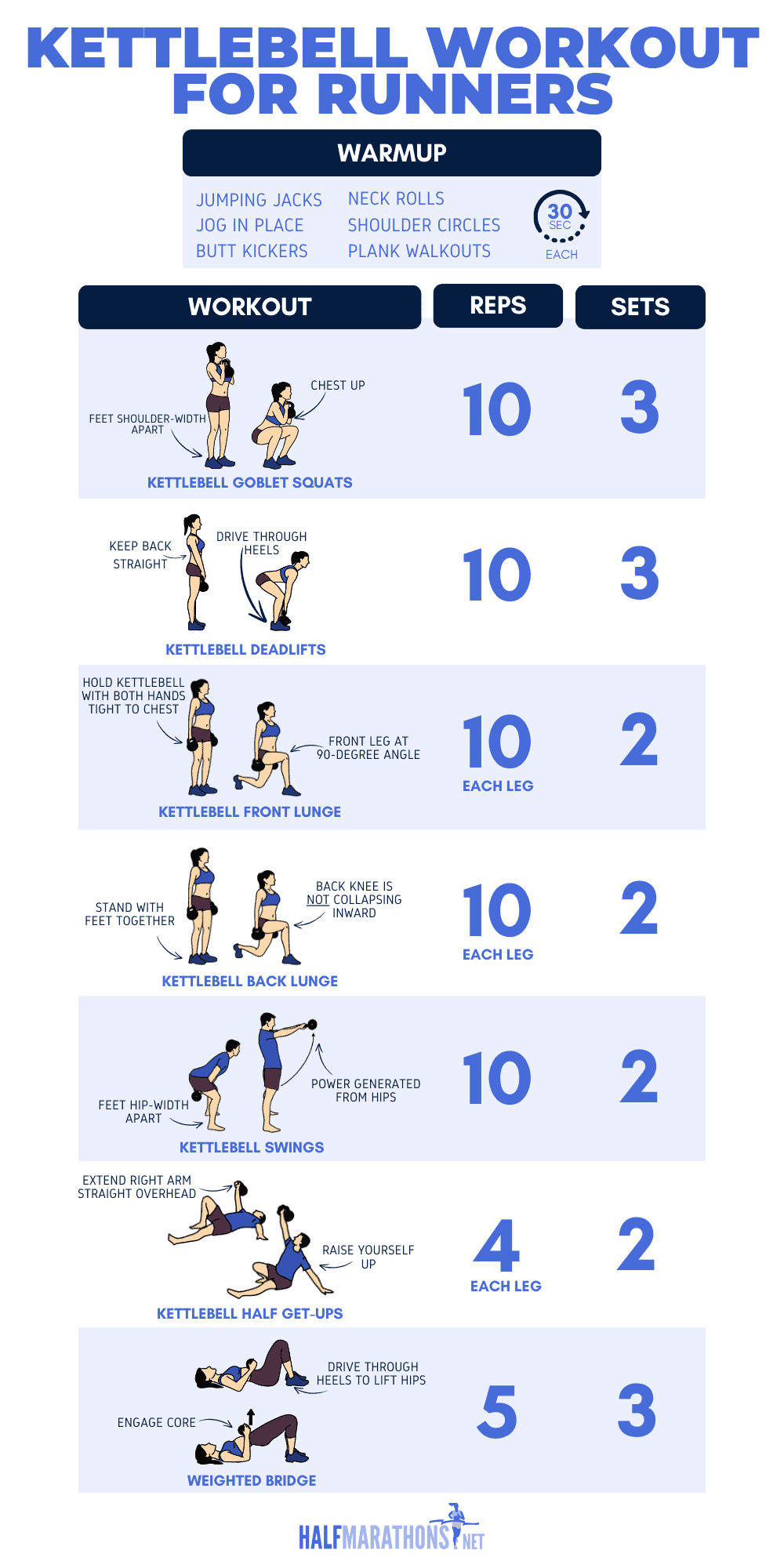
Why Trust Us?
This article was written by Ali Nolan, a runner, former features editor at Runner’s World, and author of the book Master The Marathon: The Ultimate Training Guide for Women.

